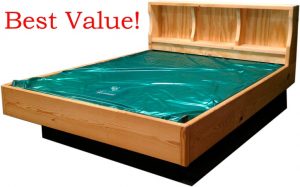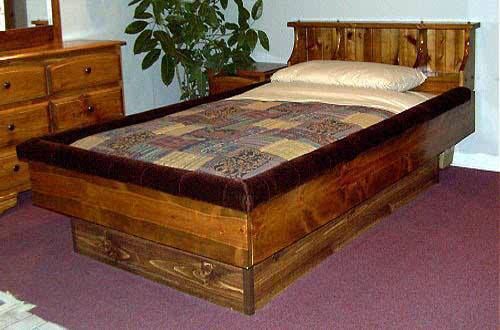If a time traveler came from the 1980s, he or she might wonder where all the waterbeds went.
Waterbeds were fairly common back then. Invented in California in the 60s, they grew in popularity over time. All together, waterbeds comprised about 20 percent of the bed market. Today, they make up a much smaller segment, about 5 percent.
They were time-consuming to set up and had to be maintained. Waterbeds had a coolness and fun factor unmatched by a more conventional box spring. They had a particular Austin-Powerslike “shagadelic” coolness factor.
Over time, people replace mattresses. They wear out. People move. When this happened, people often didn’t replace their old waterbed with another waterbed. This happened for a variety of reasons. Landlords didn’t allow them because of past experiences with water property damage. Some of the vinyl mattresses were quite fragile produced by low-quality manufacturers you find with any trend. The tenants themselves found they couldn’t move their beds easy either. Draining the beds and then refilling them was time-consuming, taking up to three hours.
After the three hours, all of the water often wouldn’t be out of the old mattress. It never would be as light as it would be out-of-the-box.
And now, as of last year at the 2019 sleep show in Houston, not one booth exhibited a waterbed. There won’t be one at the virtual sleep show this year either.
What gives?

One of the precepts this blog is things don’t always necessarily improve. Sleep is one of those areas. Sometimes advice from the past makes sense for today. We have something to learn from history. Compared to today, people generally slept better back then.
Are any advantages to the waterbed worth the biggest, single disadvantage? The simplest waterbed mattress is little more than a vinyl bag filled with water. If that bag punctures, your room is going to flood. If you’re on the second floor, that means the water is going down to the level below.
It makes sense you wouldn’t want to have a waterbed on the second floor of a building. It also makes sense if you’re a landlord, you wouldn’t want to allow a waterbed in your building. However, even people who don’t live on the second floor of a building have replaced their waterbeds. What gives?
Waterbed advantages
Why did waterbeds get to be so popular in the first place?
The reason has to do with the nature of water. Water is a liquid. It conforms to your body. This makes a mattress filled with fluid supremely comfortable when accounting for other factors.
When it’s not heated or underheated, it can be cold. If you’re in your waterbed and the heater comes unplugged, or there’s an extended power outage, your bed is going to be almost frigid and uncomfortable. Despite people sleeping better when cool, you might even find it’s too cold to sleep in and have to find someplace else to lay down for the night.
That being said, if the heater is working and you’re sore, the warmth of the water dissipates soreness in your muscles. It’s supremely healing after you’ve taken a beating from playing football or sore from working in a warehouse. The heat helps acetaminophen or ibuprofen work better.
Some people question the safety of electric heating pads. Those devices produce an electromagnetic field that may or may not be detrimental to your health. Alternates to those devices use heated water circulating through tubes in and out of a heater.
Be that as it may, when it comes to a waterbed, it’s a very safe way to apply heat to sore muscles.
Further, you can control the temperature like you can with no other mattress, making it warmer or cooler. Back in the 1980s and 90s, when I had one in my home in southern Arizona, I didn’t have an air conditioner. I did have evaporative cooling (also known as a swamp cooler) and a waterbed. I turned the heat on very low and slept well every night, even on the hot ones.
Waterbed satisfaction
Compiling information from online reviews, Sleep Like the Dead found waterbeds have a rate of 74 percent owner satisfaction. The biggest problem was with the motion of the water. Laying still, it could take up to a minute for the wave action to quiet down.
Other complaints are punctures. Pens and pencils, cats, and other objects can puncture the sides of the mattresses. Other people are bothered by the odor of the vinyl. There’s also the rise in your electric bill from heating the bed.
On the other hand, the beds tend to be affordable, they’re resistant to bed bugs, and the mattress never needs to be flipped.
Why you maybe should consider getting a waterbed
Probably the most significant reason to have a waterbed these days would be as a novelty. If you were exceptionally sore one night, you could benefit from having a bed turned to the ideal temperature.
Also, if you’re a sleeper who tosses and turns a lot, sleeping on a waterbed teaches you to be still. When you move, your body moves up and down for a bit. It’s not as disagreeable of a sensation as it might sound. In a way, it’s like being rocked in a bassinette. It’s the same thing making weighted blankets appealing.
Certain landlords may not want to rule out waterbeds automatically. If you rent out a property on a short-term basis through a site like Airbnb, you might even want to consider getting one. Airbnb provides $1 million in property damage protection and another $1 in liability protection.
There’s a particular novelty factor among people these days, as evidenced by these hosts in near Chicago and Memphis, Tennessee. Few people have had the experience of sleeping on one, and they might choose to rent from you because it is compelling.
If you’re a landlord, the risk and inconvenience might be worth it. After all, people don’t always go to bed with pockets full of metal pens, sharp compasses, and penknives! And there are other places they could rent too.
Though it defies conventional wisdom, the future of waterbeds might be found in short-term rentals.
They also might be of exceptional benefit to people who work very hard physically.
Beyond that, some people and couples might find waterbeds are as “shagadelic” as ever.
For further reading:
James Cobb RN, MSN, is an emergency department nurse and the founder of the Dream Recovery System. His goal is to provide his readers with simple, actionable ways to improve their health and maximize their quality of life.
This post includes affiliate links for which we receive a small commission if something is purchased through the link.
